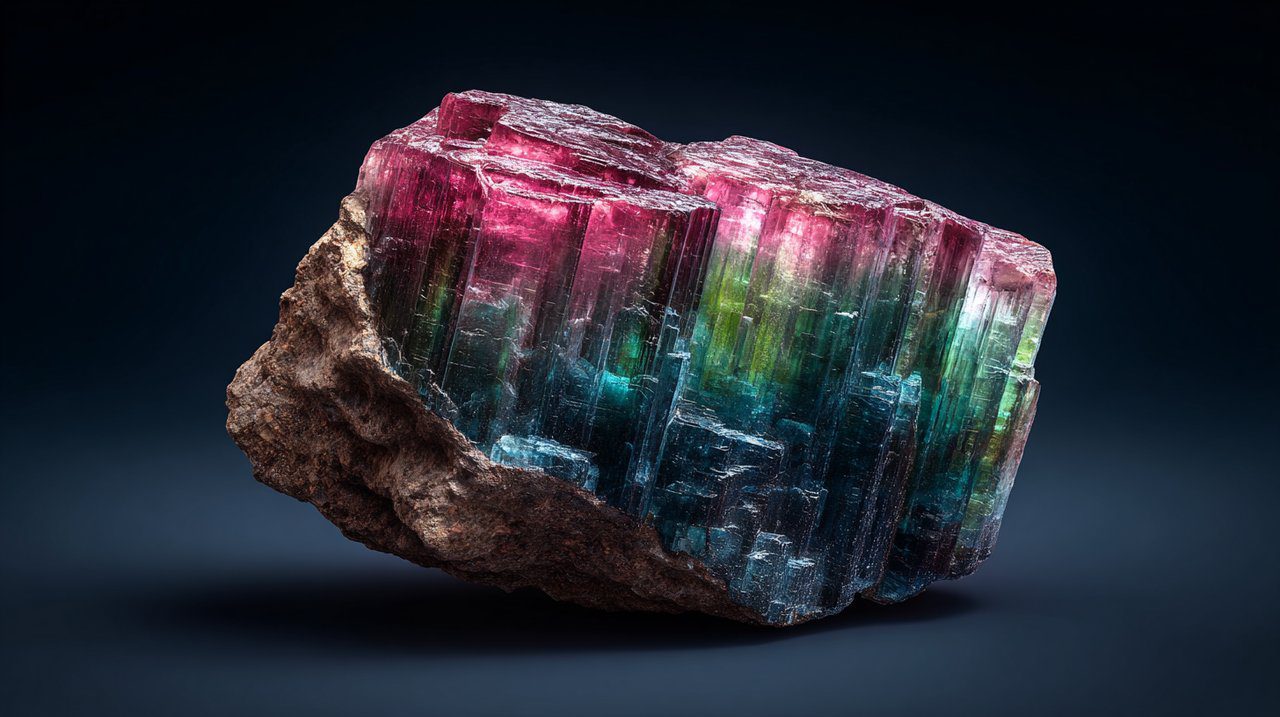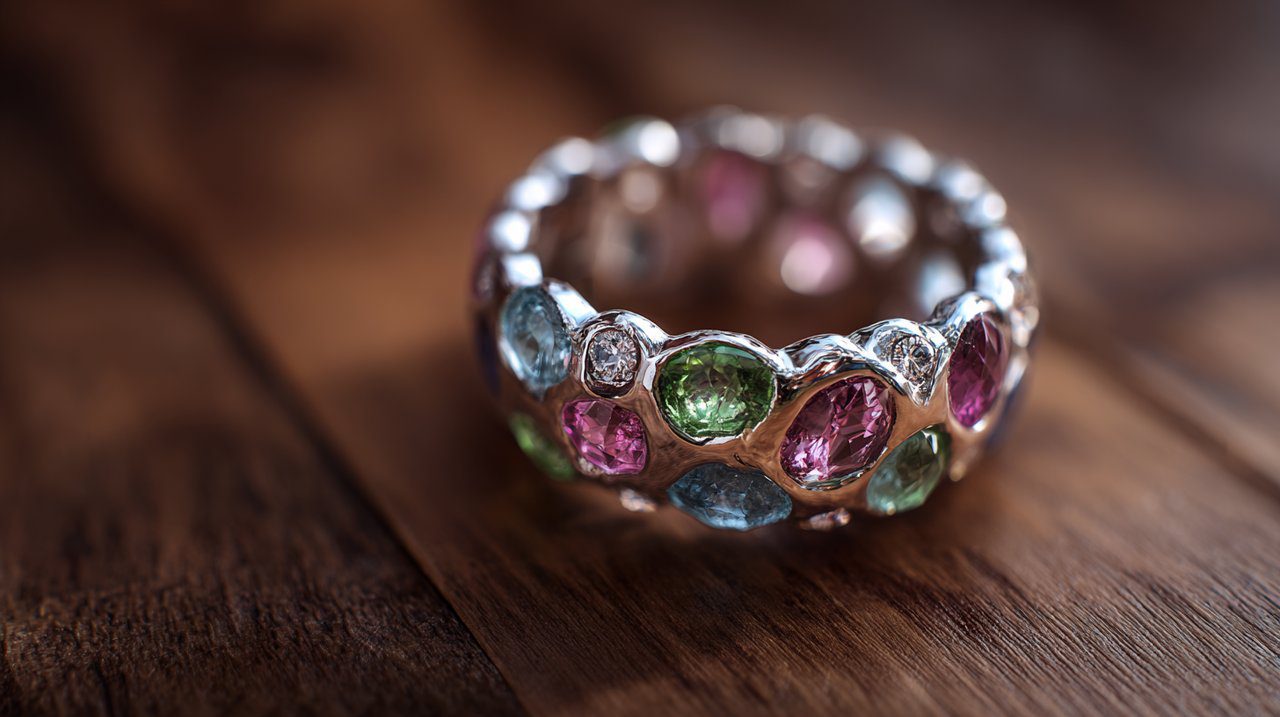Tourmaline’s Visual Journey: A Pragmatic Look at Its Appearance and Impact
The mineral world is truly captivating, full of incredible forms and colors. Among them, few stones capture our attention quite like tourmaline. Its extraordinary palette immediately sparks curiosity, making me wonder: what exactly does tourmaline look like, and how do these visual traits subtly influence our perceptions and even our well-being? For me, it’s not about magic, but rather an ancient system akin to environmental psychology.
The Kaleidoscope of Tourmaline: A Visual Feast
Tourmaline’s most striking characteristic is its incredible range of hues. This visual spectacle isn’t just random; it’s a direct result of the various trace elements that became part of its complex borosilicate structure as it formed.
A Spectrum Unveiled: Exploring tourmaline colors and Hues
Imagine a painter’s palette, but one crafted by nature over millennia. Tourmaline truly delivers on that image, appearing in virtually every color of the rainbow, and often showcasing multiple shades within a single crystal. For example, the presence of manganese frequently gives us vibrant reds and pinks, while iron and vanadium contribute to its rich greens and blues.
n n
n
This extensive range means that each specific color can, for us, become a powerful visual cue, subtly guiding a particular mood or intention. It’s fascinating how something so simple can have such a profound effect.
The Iconic Watermelon: Watermelon Tourmaline Stones Unpacked
Among its many forms, watermelon tourmaline truly stands out as a unique natural marvel. This variety typically displays a pink or red core, transitions through a white band, and is then encased by an outer green layer. This layered appearance, much like a sliced watermelon, isn’t a trick; it’s a natural phenomenon of changing mineral compositions during the crystal’s growth.
Its distinct color zoning offers a compelling visual metaphor for balance and transition—a gentle reminder that change and harmony are often intertwined.
nn
Beyond Watermelon: Diverse Types of Tourmaline and Their Looks
Beyond the famous watermelon variety, tourmaline presents itself in numerous distinct forms, each with its own visual charm:
- Black tourmaline, or Schorl, is often opaque with a deep, inky luster, visually projecting a sense of solidity and grounding.
- Pink tourmaline, known as Rubellite when it’s a rich, deep red, offers gentle, warm tones, often associated with comfort and compassion.
- Verdelite showcases a spectrum of greens, from light mint to deep forest, connecting us visually to growth and nature.
- The rare Indicolite captivates with its striking blue hues, ranging from sky blue to deep indigo, evoking feelings of calm and clarity.
Each type provides a unique visual signature, offering a different resonance for our environment.
The Architecture of Beauty: Tourmaline’s Crystalline Forms
Beyond its dazzling colors, the physical structure of tourmaline crystals significantly contributes to its overall appearance and character. These forms aren’t just accidental shapes; they are a testament to the incredible geological processes that shaped them over eons.
From Rough to Refined: Natural Crystal Habits
Tourmaline commonly forms in elongated, prismatic crystals, often featuring distinctive vertical striations running along their length. These parallel grooves are a signature characteristic, almost like nature’s fingerprint. The crystal ends can vary greatly, from flat terminations to complex pyramidal shapes, all adding to their unique aesthetic.
Observing these natural habits helps us appreciate the raw, unpolished beauty of the stone, reminding us of the natural world’s intricate design.
Luster and Transparency: What Makes It Shine
When polished, tourmaline typically exhibits a vitreous, or glass-like, luster. Its transparency can range dramatically: some pieces are completely transparent, allowing light to pass through unimpeded, while others are opaque, where light cannot penetrate at all. This variation means that some tourmalines sparkle with internal fire, while others offer a more muted, grounding presence.
The way light interacts with the stone’s surface and internal structure is absolutely key to its visual dynamism—it’s what makes each piece truly come alive.
Beyond the Surface: Connecting Appearance to Perceived Properties (Alex Chen’s Lens)
Here’s where my curiosity truly ignites! I don’t believe tourmaline possesses magical powers, but I am utterly fascinated by how its visual and physical attributes can become powerful tools for environmental psychology and positive suggestion. It’s all about how we perceive and interact with our surroundings.
Colors as Psychological Anchors: Unveiling tourmaline meaning
When we talk about the "meaning" of tourmaline’s colors, it’s less about inherent mystical energy and more about established psychological associations and cultural symbolism. Think about it: a deep black tourmaline, with its solid, opaque appearance, can naturally act as a visual anchor for grounding and protection. Its visual weight and lack of transparency subtly suggest a boundary, helping us mentally reinforce our sense of personal space and resilience.
Similarly, the soft, inviting pinks can serve as a gentle visual reminder to cultivate self-love and compassion, simply by being present in our environment. It’s about creating a subtle, positive feedback loop.
Energetic Resonance: Tourmaline and tourmaline chakras
The concept of tourmaline’s "energy" resonating with specific chakras can also be understood through a rational, psychological lens. Each chakra is associated with particular colors and aspects of well-being. Therefore, placing a green tourmaline (often linked to the heart chakra) in your space or wearing it can function as a visual and tactile reminder to focus on emotional balance and connection.
It doesn’t *transfer* energy; rather, it acts as a tangible prompt, gently guiding our intentions and self-reflection towards those specific areas. It’s a powerful tool for mindful focus, not mystical intervention.
n n
n
A Practical Eye: How to How to Identify Tourmaline Visually
Understanding tourmaline’s visual characteristics also equips us with the practical knowledge to identify it. Knowing what to look for can genuinely help distinguish genuine pieces from imitations—it’s all about becoming a keen observer.
Key Visual Indicators: Color Zoning, Luster, and Crystal Habit
When identifying tourmaline, look for several key visual indicators. Color zoning, where different colors appear within the same crystal, is a strong clue, especially in varieties like watermelon tourmaline. Its characteristic vitreous luster and the vertical striations on its prismatic crystals are also highly indicative. Additionally, tourmaline often exhibits pleochroism, meaning its color appears to change when viewed from different angles—a truly fascinating optical effect.
Common Imitations and How to Spot Them
It’s wise to be aware that tourmaline can be imitated by materials like colored glass or synthetic spinels. Visually, glass often contains tiny air bubbles, which are usually absent in natural tourmaline. Also, the color in glass or dyed stones tends to be perfectly uniform, lacking the natural variations, inclusions, and color zoning often seen in genuine tourmaline.
A keen eye for these subtle differences is your best visual guide in discerning authenticity.
Tourmaline, in all its astonishing forms, offers a truly rich visual experience. Its myriad colors and distinct crystalline structures provide not just aesthetic pleasure, but also a fascinating case study in how our environment, through simple visual cues, can subtly influence our psychological landscape. Whether you’re drawn to its vibrant hues or its grounding forms, tourmaline serves as a beautiful, tangible reminder to engage with the world around you with intention and curiosity.
Perhaps, by simply having a piece of green tourmaline on your desk, you’re not just admiring a stone, but subtly encouraging a moment of balance in your busy day. It’s these small, intentional connections that truly make a difference.
💡 Häufig gestellte Fragen
Tourmaline is most known for its incredible range of hues, appearing in virtually every color of the rainbow and often showcasing multiple shades within a single crystal. This diverse palette results from various trace elements present during its formation.
Watermelon Tourmaline is a unique variety that typically displays a pink or red core, transitions through a white band, and is then encased by an outer green layer. This layered appearance is a natural phenomenon caused by changing mineral compositions during the crystal's growth.
The article suggests that tourmaline's visual traits act as powerful visual cues, subtly guiding mood or intention, similar to environmental psychology. For instance, deep black tourmaline can serve as a visual anchor for grounding, while soft pinks can remind us of compassion.
To identify tourmaline, look for color zoning (different colors within the same crystal), a vitreous (glass-like) luster, and distinctive vertical striations along its elongated, prismatic crystals. It may also exhibit pleochroism, where its color appears to change from different angles.







